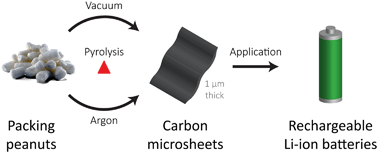Environmental impact, life cycle analysis and battery performance of upcycled carbon anodes
Abstract
For rechargeable lithium ion batteries, natural and synthetic graphite anodes come with great economic and environmental costs. Carbon microsheets, developed from used starch packing peanuts, are a carbonaceous alternative with great electrochemical performance and quantifiable environmental footprint. This work investigates how synthesis route (e.g., ambient inert gas or vacuum) influences microsheet electrochemistry and environmental impact. Carbon microsheets show gravimetric capacity greater than conventional graphite, with argon-derived microsheets demonstrating gravimetric capacity up to ca. 30% greater than vacuum-derived ones. Life cycle assessment (LCA) is used to examine the environmental impact of synthesis routes across standard midpoint TRACI categories (viz., ozone depletion, global warming, smog, acidification, eutrophication, carcinogenics, non-carcinogenics, respiratory effects, eco-toxicity, and fossil fuel depletion). Midpoint LCA illustrates that the impact of the vacuum process is sensitive to the origin of utilized energy. For instance, with respect to ozone depletion, vacuum pyrolysis produces less emission equivalents than its argon analog – assuming conventional domestic energy profile. In this sense, the context of energy should be considered alongside environmental impact in evaluation of process sustainability.

- This article is part of the themed collection: Nanomaterials in air


 Please wait while we load your content...
Please wait while we load your content...